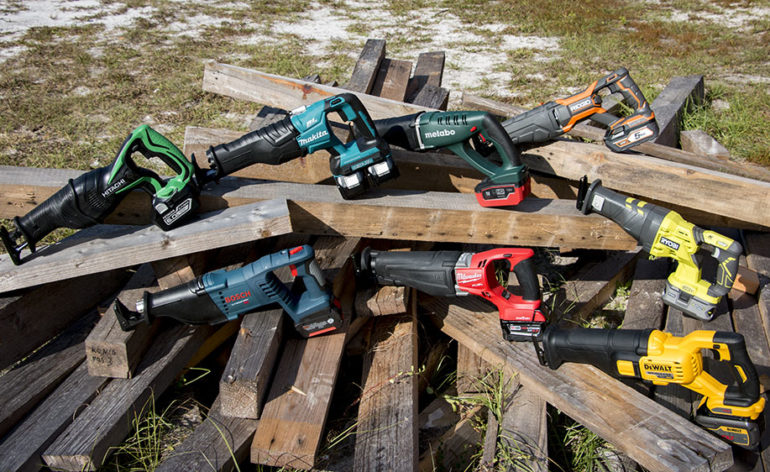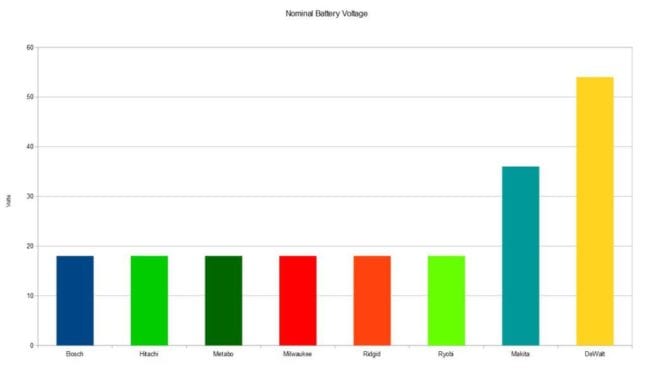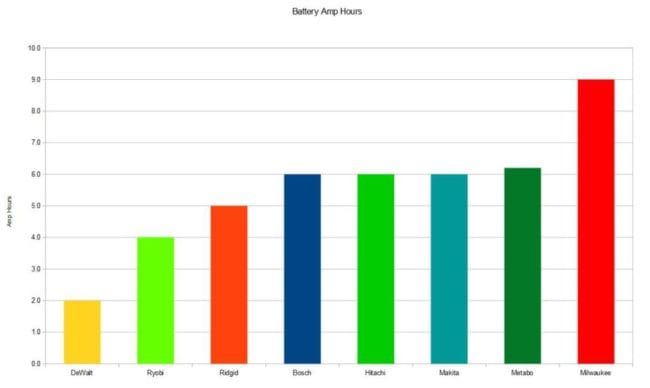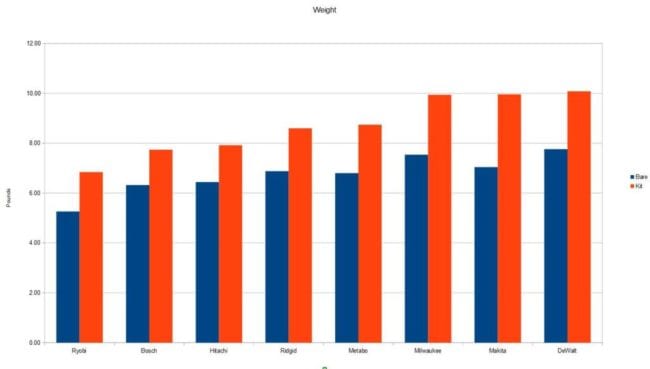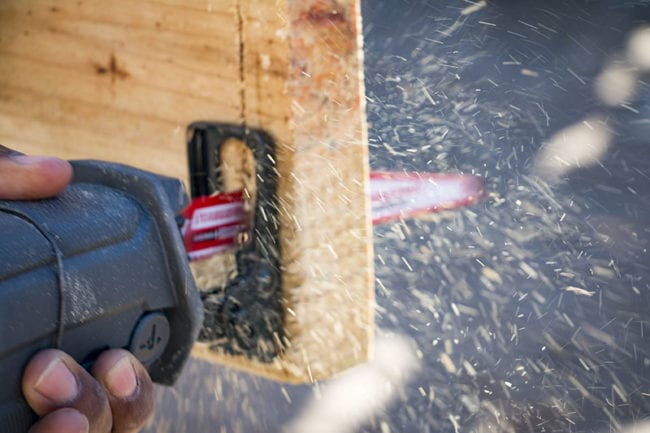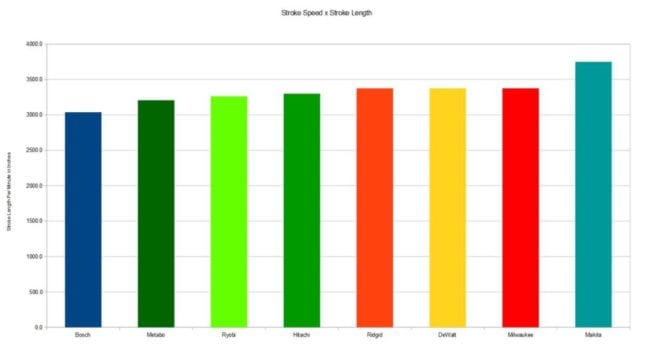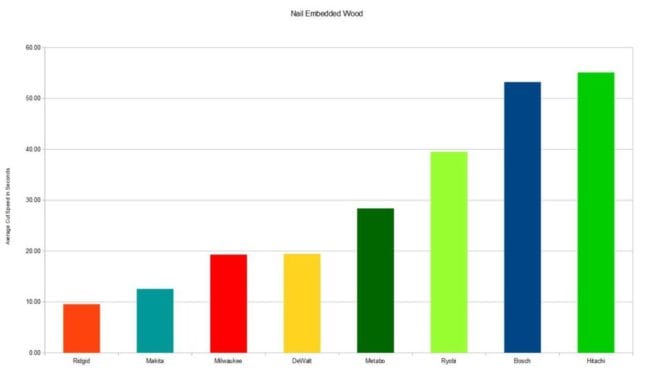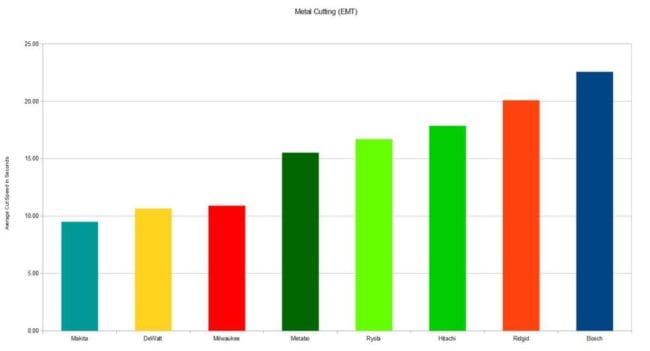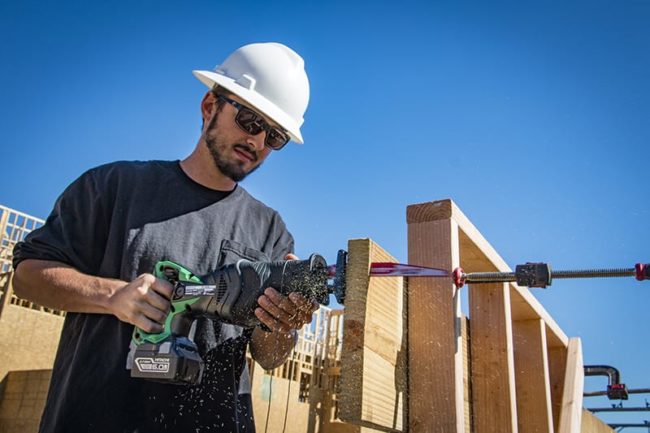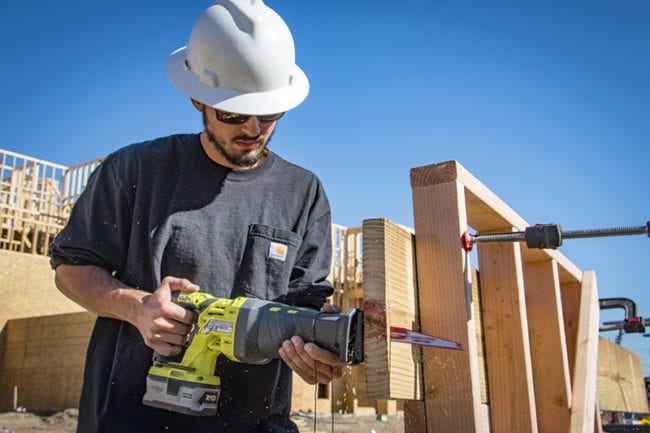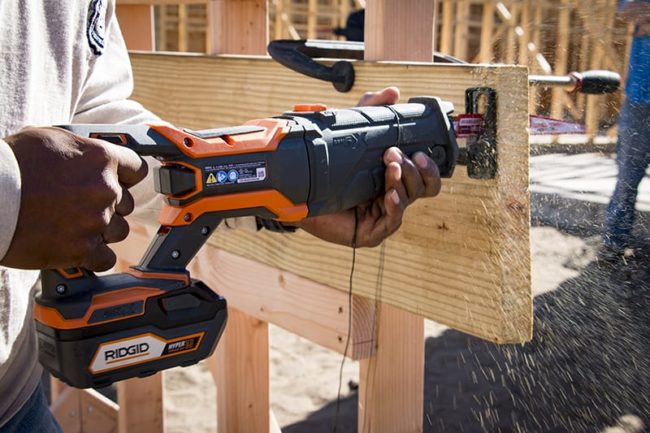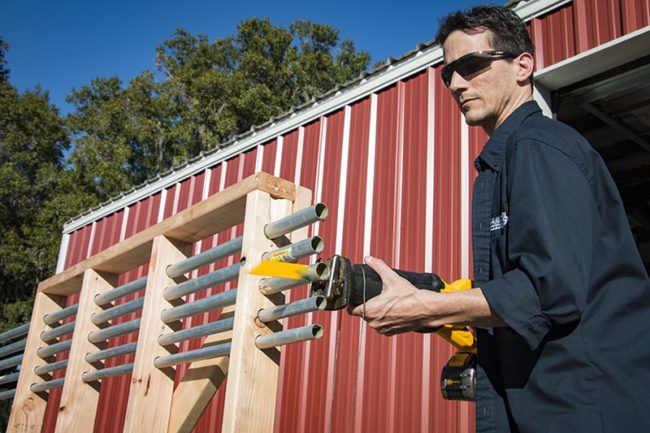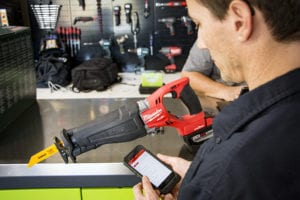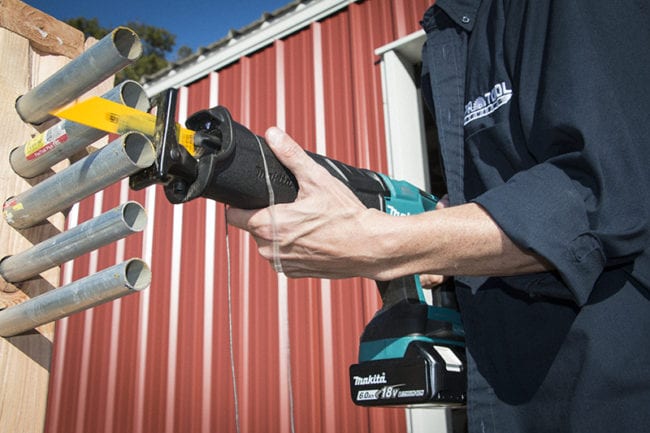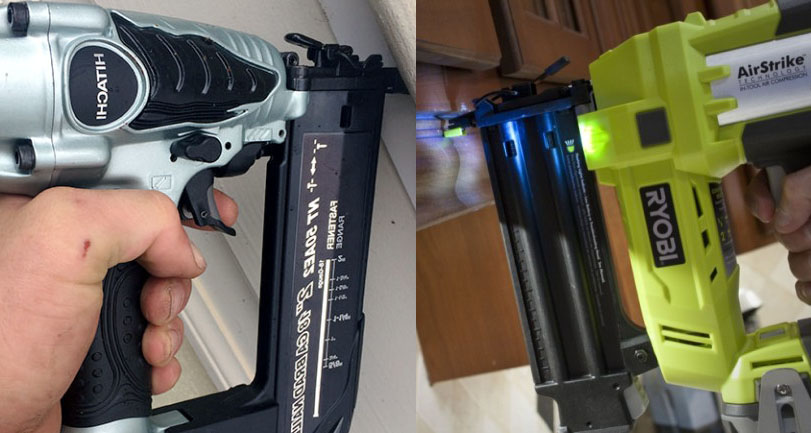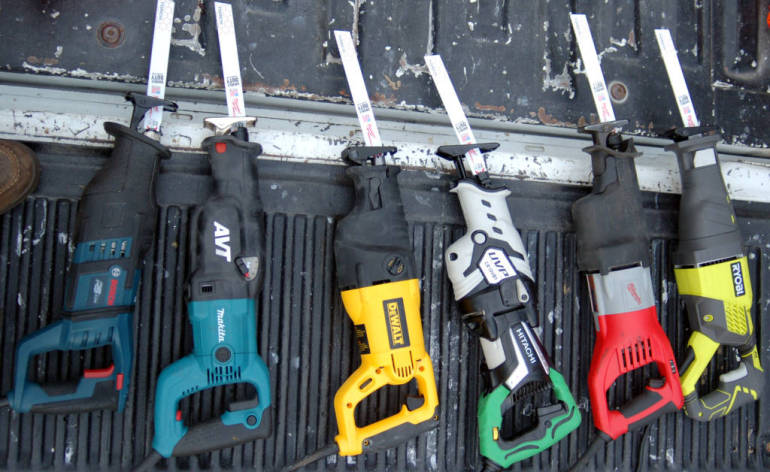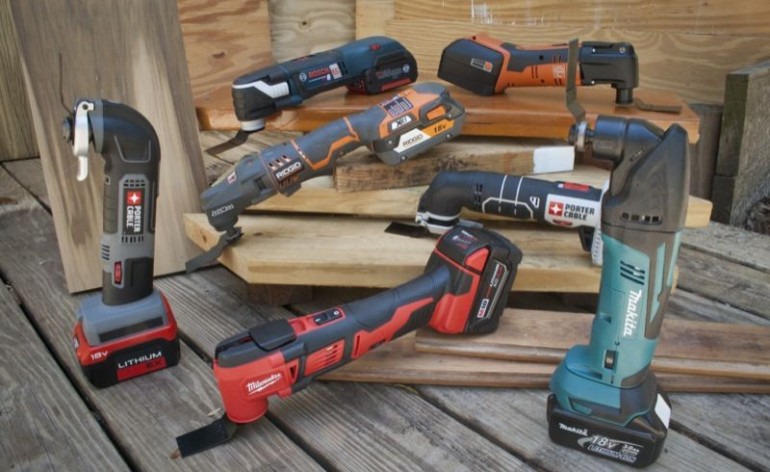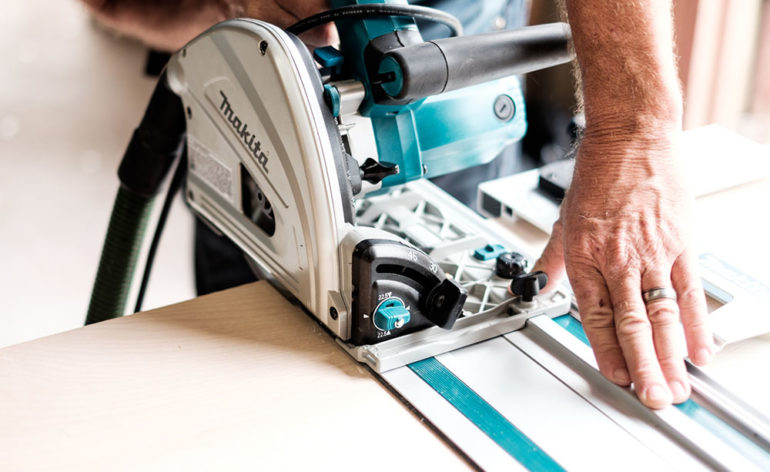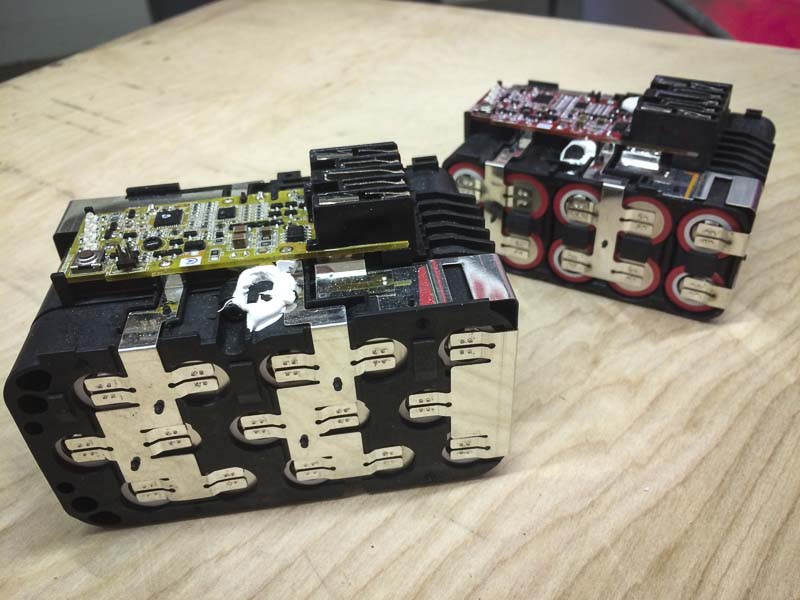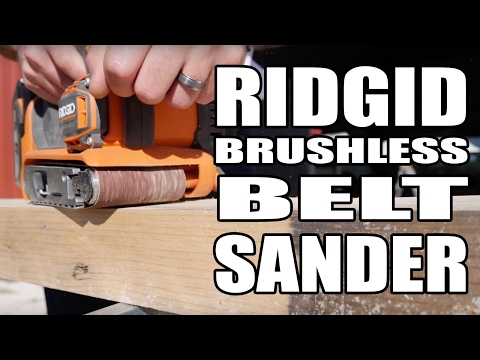
Eight saws, an endless supply of new blades, and a few editors with nothing better to do than cut stuff
If you’ve been with us for a few years, you may remember our Heavy-Duty reciprocating saw shootout from a while back. How this classic demo saw is used hasn’t changed much, but the saws themselves have changed drastically—thanks to battery technology.
Whether you’re here to see how your favorite brand did or are looking for the best cordless reciprocating saw for your needs, we’ve got eight of the most popular brands lined up with their highest performing cordless saws.
Normally, you’d see us go with something like an 18V shootout and keep it to a clearly defined class. However, high performance and new technology are changing the landscape for cordless tools, including the reciprocating saw.
Milwaukee has their One-Key system in full force along with their M18 High Demand 9.0 amp hour battery.
DeWalt FlexVolt technology series launched earlier this year and is rocking with a 60V Max platform for their top performer.
Makita brings their brushless motor technology and pairs it with their 18V X2 line to offer 36V performance.
Determining the Best Cordless Reciprocating Saw
There are a ton of ways to figure out which saw should top our list, but we’ve dialed in what our pros find to be the most important traits, starting with cutting performance. We put each saw through both wood and metal cutting tests to see how fast they can get the job done.
From there it’s on to ergonomics—vibration is the most important in this category. Even the best cordless reciprocating saw can leave you feeling beat up by the end of the day and professionals are likely to sacrifice a little bit of speed for less vibration.
Weight is an important ergonomic consideration as well and pairs up with the feel of the saw in your hand. The more natural the saw feels, the more likely you’re going to be using it correctly and working with the shoe to dial in efficient cuts.
Finally, there are the features. With technology and design taking us to new heights, features are more than just a rafter hook (though I really like having a rafter hook). There are features on several of these saws that directly affect their performance and/or ergonomics.
Keeping it fair
To control as many variables as we can and keep the evaluation all about the saws, we gave each saw the same blades—Diablo.
For wood applications, we’re using the Diablo Demo Demon Carbide-Tipped Recip Blades.
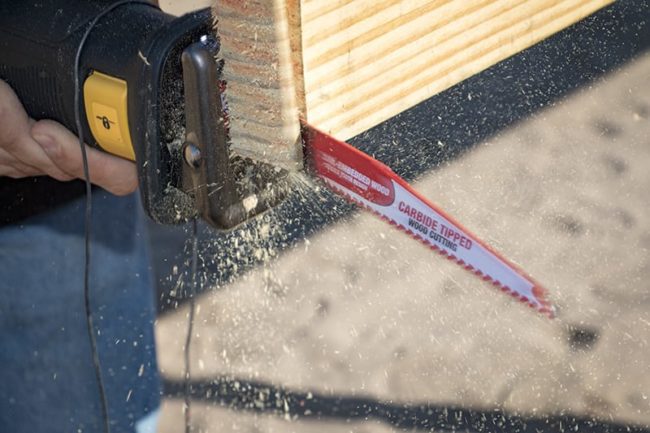 There are plenty of good reasons to go with the Steel Demon starting with durability. Diablo claims up to 20 times the life of a bi-metal blade in nail embedded wood applications thanks to their carbide blend.
There are plenty of good reasons to go with the Steel Demon starting with durability. Diablo claims up to 20 times the life of a bi-metal blade in nail embedded wood applications thanks to their carbide blend.
That same blend gives these blades the ability to cut through tough materials like fluted masonry nails designed to attach wood to concrete walls.
They feature a variable tooth design in a 6/9 TPI configuration that helps reduce vibration while increasing cutting speed. Vibration is also reduced and stability is enhanced with a full 1-inch blade body. It wraps up with a plunge cutting tip for when the edge of the material isn’t your primary target.
We initially wanted to go with the Diablo Steel Demon Carbide Tipped recip blades, but they actually proved to be a bit heavier duty than the metal application we chose. These are great for cutting through thick metal cutting applications, including Hulk-esque materials like cast iron.
The carbide blend and aggressive tooth pattern allows them to dig in where other blades can literally only scratch the surface. In the end, a standard bi-metal blade in a variable 14/18 TPI configuration was the best option for this test.
Keep your eyes open for our reviews on both the Diablo Demo Demon and Steel Demon Carbide Tipped recip blades soon!
Voltage, Amp Hours, and Watt Hours
If you’ve been a reader of ProToolReviews for a while, you know that we take batteries seriously. You may also remember that the amount of power delivered by a battery can be stated using the equation:
Volts x Amp Current = Watts Out (Power)
Taking a look at the list of saws we have to choose from, we have several different voltages.
DeWalt comes in the highest with 60V Max (54V nominal) followed by Makita with their 18V X2 LXT delivering 36V and then the rest of the crew at 18V.
You’d think that would give DeWalt and Makita a clear advantage, but volts don’t tell the entire story.
Battery amp hours also come into play.
Milwaukee is the clear leader with a 9.0 amp hour pack and a large gap back to Metabo with their 6.2 amp hour LiHD battery.
Bosch, Hitachi, and Makita all have 6.0 amp hour packs. Ridgid comes in with 5.0 amp hours, Ryobi drops to 4.0, and DeWalt delivers just 2.0 amp hours when the FlexVolt battery runs at 60V Max.
When you multiply the nominal voltage of the pack and the number of amp hours available to it, you get an idea of how much energy is actually available.
Think of it like a gas tank – an engine can be incredibly efficient or be a gas guzzler. The more fuel it has available, however, the longer it will be able to run.
A lower voltage tool can compete with higher voltage by drawing a higher current to produce additional power. On the other side of the coin, a higher voltage tool can run at a lower current draw to extend the battery when it doesn’t need all the power it can muster.
Makita comes away with the largest gas tank at 216 watt hours – a full 33% higher than Milwaukee’s 162 watt hours. This is thanks to the use of two 6.0 amp hour batteries.
There’s another gap to Metabo at just under 112 watt hours and it goes down from there to finish with Ryobi at 72 watt hours.
Ergonomics
Weight
While much of the discussion about ergonomics is subjective—we all have different size hands, slightly different techniques, and varying arm strength, weight is clear-cut.
With batteries installed, Ryobi is the lightest at 6.84 pounds followed by Bosch at 7.74 pounds and Hitachi 7.92 pounds.
Milwaukee (9.94 pounds), Makita (9.96 pounds), and DeWalt (10.08 pounds) top the heavyweight ticket.
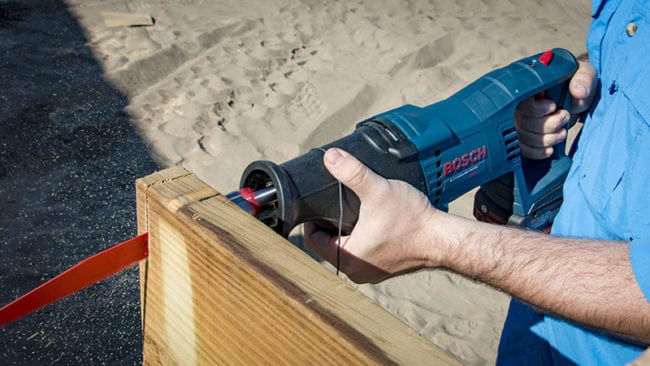
Grip
There’s no one-size-fits-all handle design for any tool. People with smaller hands will prefer one handle type while people with larger hands will prefer another.
We took into consideration how natural a grip we could get on each of the reciprocating saws and how comfortable each handle was while trying to keep in mind that everyone’s hand size will be a little different.
- Bosch takes the top spot with a front handle that pushes your hand forward into a very natural and stable grip while the back handle was reasonably comfortable.
- Hitachi comes in second also placing your front hand in a natural and stable grip. The front handle was slightly less natural than Bosch, but it had a more contoured trigger handle.
- Rounding out the podium was DeWalt edging out Metabo.
- The rest of the group pretty much finished up together.
One worth noting is Makita, who typically has outstanding ergonomics. The front handle left me challenged to try and find a natural grip. Much of that is due to the size of my hands and a couple of the other guys mentioned it fit their large hands nicely.
Vibration
The amount of vibration you feel when using a reciprocating saw often comes down to your technique. Some materials allow you to press the shoe against it and really stabilize the cut while other material, like round steel pipe, takes a bit more work.
We looked at the amount of vibration we felt in our hands and arms in each of the materials we tested.
- Hitachi separated itself as the winner in vibration. It’s lower cutting speed may have contributed to that, but it was noticeably better than the others.
- Makita came in second followed by our German friends, Bosch and Metabo.
- From there Milwaukee, DeWalt, and then Ryobi rounded out the list.
Rigid was a bit of a paradox when it comes to vibration. In non-orbital mode it had nearly as little vibration as Hitachi when cutting through wood, but the most vibration of all the saws in orbital mode. In the end, it finishes in the middle of the pack when averaging out the two perceived vibration rates.
Performance Testing
Recip saws are used in a variety of demo applications, but we find the majority of their time is spent cutting wood, nail embedded wood, and reasonably light metal like EMT.
There are certainly tougher tasks than these – they just don’t make up the meat and potatoes of a recip saw’s day.
It’s not just the saw’s power that determines how fast it’s going to cut through material, it’s also a function of the stroke length and the stroke speed.
By multiplying the stroke length and the number of strokes per minute, we can look at how many linear inches each tool is sawing per minute.
Nail Embedded Wood

For testing in wood applications, each saw was required to make a cross cut through 2 x 12 pressure treated pine with five 16D galvanized nails in it.
Each saw would start with a brand new Diablo Demo Demon Carbide Tipped Recip Blade and make three successive cuts.
Their final score was calculated as an average of the three cuts.
To keep the test fair, a pair of weights provided a consistent 10 pounds of down force and we only used our arms to stabilize each saw against the wood as we cut.
With friendly bets taken, we lined up the saws and got to work. After testing all eight saws, the Ridgid Gen5X blew away everyone else.
Surprised?
Many Pros would have guessed this one without ever picking the saws up.
Ridgid (9.54 seconds) is the only model in this group that includes an orbital action. The aggressive nature of the cut created a gap to Makita (12.55 seconds) and Milwaukee (19.28 seconds).
Having used plenty of corded recip saws that include orbital action, it seems to beg the question as to why the other brands left it off their best cordless reciprocating saw.
That said, we have it on good authority (but we can’t tell you the details yet) that several of these brands have new models coming out for 2017.
Metal Cutting
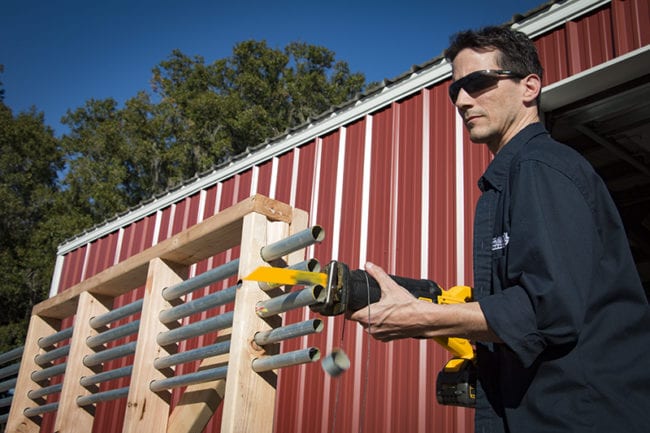
There are a variety of metal materials you’ll come into contact with when doing demolition work with a reciprocating saw. To simulate metal cutting, we went with a series of five pieces of EMT – three 1-inch pipes and two 3/4 inch pipes.
Like we did with the wood, the same 10 pound weights would be producing the down force on each saw and we would only use our arms to stabilize the cut as the blade moved through the material.
Starting with a new blade, three successive cuts were made, and the final score was taken from the average of those cuts.
With orbital action no longer a factor, the race became a lot tighter.
The names you’d expect to be out front were with Makita (9.50 seconds) in first place, DeWalt (10.65 seconds) in second, and Milwaukee (10.90 seconds) rounding out the podium.
The Best Cordless Reciprocating Saw Rankings
Editor’s note: Some requested brands declined to participate in The Best Cordless Reciprocating Saw Shootout. Several companies have new models due out in 2017.
Bosch 18V Lithium-Ion Reciprocating Saw
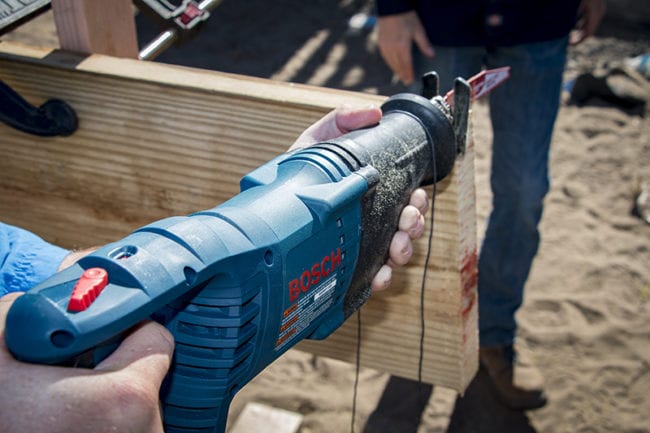
Specifications
- Model: Bosch CRS180
- Voltage: 18V
- Stroke Length: 1-1/8″
- No Load Speed: 0-2,400 / 0-2,700
- Orbital Action: no
- Vibration Control: no
- Weight (Bare): 6.32 pounds
- Weight (With 6.0 AH Battery): 7.74 pounds
- Warranty: 1 year
- Price: $119 (bare) – $309 (multiple kit options)
Key Features
- Brushed motor
- Lock-Jaw blade lock allows one-handed blade insertion, but requires twisting the lock on the shaft to release it
- Pivoting shoe does not have adjustable length
- Selectable speed switch mechanically governs trigger for low speed, flip to center for lock off and right for high
- Fairly lightweight and best ergonomic grip in the group
- Battery life indicator on battery
Results:
- Average Speed in Nail Embedded Wood Cutting Test: 53.21 seconds (7th place)
- Average Speed in Metal Cutting Test: 22.57 seconds (8th place)
- Ergonomics: 2nd place
- Overall: 8th place
Bosch’s entry in the Best Cordless Reciprocating Saw Shootout is highlighted by excellent ergonomics. While cutting performance is relatively slow, it’s not a saw that will beat you up the way some other saws do.
The Lock-Jaw blade lock is a standout feature for this model, keeping the blade lock open and automatically locking it when you insert a blade. This saw has been around for a while and after the success of Bosch’s 18V compact reciprocating saw, it wouldn’t shock me to see a new brushless model coming sometime in 2017.
Hitachi 18V Lithium-Ion Reciprocating Saw
Specifications
- Model: Hitachi CR18DSLP4
- Voltage: 18V
- Stroke Length: 1″
- No Load Speed: 0-3,300 SPM
- Orbital Action: no
- Vibration Control: no
- Weight (Bare): 6.44 pounds
- Weight (With 6.0 AH Battery): 7.92 pounds
- Warranty: Lifetime Lithium Ion Tool Warranty
- Price: $151.99
Key Features
- Brushed motor
- Blade lock lever on shaft doesn’t require twisting
- Shoe adjustment requires tool
- Lock off switch
- Ergonomic and reasonably lightweight design
- Lowest vibration in the group
- 6.0 amp hour battery available
- Battery life indicator on tool
Results:
- Average Speed in Nail Embedded Wood Cutting Test: 55.10 seconds (8th place)
- Average Speed in Metal Cutting Test: 17.86 seconds (6th place)
- Ergonomics: 1st place
- Overall: 7th place
We’ve pretty much come to expect excellent ergonomics from Hitachi on most of the tools we review from them and their 18V reciprocating saw is no exception.
Relatively slow cutting speed is offset by the lowest vibration we felt in any of the saws. Now that Hitachi has a 6.0 amp hour battery and they’ve started rolling out some new innovative cordless tools, this is another brand that wouldn’t surprise me with a new brushless reciprocating saw in the near future.
Ryobi 18V One+ Reciprocating Saw
Specifications
- Model: Ryobi P516
- Voltage: 18V
- Stroke Length: 1-1/8″
- No Load Speed: 0 – 2,900
- Orbital Action: No
- Vibration Control: Anti-Vibe handle
- Weight (Bare): 5.26 pounds
- Weight (With 4.0 AH Battery): 6.84 pounds
- Warranty: 3 year
- Price: $79 (bare)
Key Features
- Brushed motor
- Standard blade lock lever on side of upper housing
- Shoe adjustment requires hex wrench
- New vibration control includes separated anti-vibe back handle
- Lock off switch
- Lightest saw in the group
Results:
- Average Speed in Nail Embedded Wood Cutting Test: 39.51 seconds (6th place)
- Average Speed in Metal Cutting Test: 16.70 seconds (5th place)
- Ergonomics: 3rd place
- Overall: 6th place
Ryobi continues to be one of a very select group of companies that bridges the gap between professional users and weekend warriors. Part of what makes them so impressive is the breath of their cordless lineup and part of it is the consistently decent performance they get from the tools while maintaining an outstanding price point.
Ryobi’s 18V reciprocating saw comes in as a lightest in the group and has a little better vibration control with a newly designed handle. While it’s not going to knock your socks off, it will absolutely get the job done and $79 for the bare tool is a price that no one else in this group can touch.
Ridgid Gen5X 18V Cordless Reciprocating Saw
Specifications
- Model: Ridgid R8642
- Voltage: 18V
- Stroke Length: 1-1/8″
- No Load Speed: 0-3,000 SPM
- Orbital Action: Yes
- Vibration Control: No
- Weight (Bare): 6.88 pounds
- Weight (With 5.0 AH Battery):8.60 pounds
- Warranty: 3 year
- Price: $119 (bare) – $399 (multiple kit options)
Key Features
- Brushed motor
- Standard shaft twist blade lock
- Tool-free shoe lock below front housing
- Lock off switch
- Orbital mode made for fastest cutting in wood
Results:
- Average Speed in Nail Embedded Wood Cutting Test: 9.54 seconds (1st place)
- Average Speed in Metal Cutting Test: 20.08 seconds (7th place)
- Ergonomics: 5th place
- Overall: 5th place
The Ridgid Gen5X 18V reciprocating saw is an all-around solid performer. Having the only orbital action in the group–and including it even in their previous model–it’s no surprise that they blew everyone away when cutting through nail embedded wood. It came back down to earth when it came to metal cutting speed, but it handled vibration very well when it wasn’t in orbital mode.
Several cordless tools from Ridgid in the Gen5X line this year have included brushless motors, so don’t be surprised if you see one for the recip saw next.
Now that they have a hammer drill, impact driver, and circular saw with brushless motors, all that’s missing is a brushes reciprocating saw to build the standard 4-piece general contractor’s kit.
Metabo ASE 18 LTX Cordless Reciprocating Saw
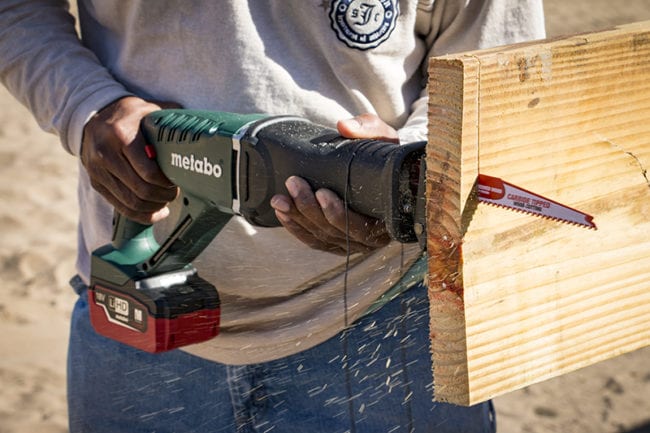
Specifications
Model: Metabo 602269850- Voltage: 18V
- Stroke Length: 1-3/16″
- No Load Speed: 0 – 2,700
- Orbital Action: No
- Vibration Control: No
- Weight (Bare): 6.80 pounds
- Weight (With 6.2 AH LiHD Battery): 8.74 pounds
- Warranty: 3 year
- Price: $169 (bare)
Key Features
- Brushed motor
- Blade lock
- Tool required for shoe adjustment
- Have to press and hold in safety switch while starting motor
- Metabo LiHD batteries extend run time and boost power
Results:
- Average Speed in Nail Embedded Wood Cutting Test: 28.37 seconds (5th place)
- Average Speed in Metal Cutting Test: 15.52 seconds (4th place)
- Ergonomics: 4th place
- Overall: 4th place
When we took the best reciprocating saws available out to the jobsite to give some of the Pros a shot at using them, they had simply never heard of Metabo. That’s not terribly surprising considering the relatively small distribution and focus on metalworking.
However, their LiHD batteries are game changing. Need proof? Take a look at the Metabo 9-inch grinder they’ve come up with on their 36V battery platform!
Featuring German engineering, Metabo’s tools tend to be precise machines. Even though their cordless reciprocating saw has been out for several years, it still performed very well being bested by only the most recent models.
The safety is a bit awkward to defeat since you have to push it in and pull the trigger at the same time rather than simply sliding over a lock off switch. Metabo is another company that is due for a new cordless reciprocating saw and with their new battery technology, I expect it to raise some eyebrows whenever they decide to tackle that project.
DeWalt FlexVolt 60V Max Brushless Reciprocating Saw
Specifications
- Model: DeWalt DCS388B
- Voltage: 60V Max (54V nominal)
- Stroke Length: 1-1/8″
- No Load Speed: 0-3,000 SPM
- Orbital Action: No
- Vibration Control: No
- Weight (Bare): 7.76 pounds
- Weight (With 2.0 AH Battery): 10.08 pounds
- Warranty: 3 year
- Price: $180 (bare) – $380 (multiple kit options)
Key Features
- Brushless motor
- Standard blade lock lever on side of upper housing
- Pivoting shoe, but length is not adjustable
- Lock off switch
- FlexVolt 60V Max (54V nominal)
- 162 watt hour battery coming soon (60V Max, 3.0 amp hour)
Results:
- Average Speed in Nail Embedded Wood Cutting Test: 19.44 seconds (4th place)
- Average Speed in Metal Cutting Test: 10.65 seconds (2nd place)
- Ergonomics: 8th place
- Overall: 3rd place
In the build up to our Best Cordless Reciprocating Saw Shootout, several people commented that DeWalt should dominate it with their 60V Max FlexVolt platform. While it performed very well, especially in metal cutting, the average ergonomics and high weight ended up relegating it to third-place.
As DeWalt continues to develop the FlexVolt line, additional features like an orbital action will boost its woodcutting performance significantly. Don’t expect it to get much lighter though. The FlexVolt line is all about producing power that DeWalt couldn’t easily get on its 20V Max line and that comes at a cost.
There’s been plenty of talk about the FlexVolt battery and their new 162 watt hour version is due out in just a couple of months which will will boost the runtime.
As far as performance goes, the FlexVolt is a good place to start as DeWalt begins to dial in exactly what professional users will demand out of a reciprocating saw (among other cordless tools) that operates at this high of a voltage.
Milwaukee M18 Fuel Sawzall with One-Key
Specifications
- Model: Milwaukee 2721-20
- Voltage: 18V
- Stroke Length: 1-1/8″
- No Load Speed: 0 – 3,000
- Orbital Action: No
- Vibration Control: No
- Weight (Bare): 7.54 pounds
- Weight (With 9.0 AH Battery): 9.94 pounds
- Warranty: 5 years
- Price: $250 (bare) – $549 (multiple kit options)
Key Features
- Brushless motor
- Blade lack slide on side of front housing
- Standard tool-free shoe lock lever under front housing
- Rafter hook included
- One-Key enabled with 4 customizable settings
- Available 9.0 amp hour battery
- Lock off switch
Results:
- Average Speed in Nail Embedded Wood Cutting Test: 19.28 seconds (3rd place)
- Average Speed in Metal Cutting Test: 10.90 seconds (3rd place)
- Ergonomics: 7th place
- Overall: 2nd place
Many of the folks that thought someone other than DeWalt would take home the top prize as the Best Cordless Reciprocating Saw naturally chose Milwaukee–after all, they invented this class of tool. Like others, the M18 Fuel Sawzall would benefit from orbital action.
Where Milwaukee stands out away from everyone else in this group is with their One-Key technology and the customizable settings that come with it. It’s more than just setting the blade speed though.
For metal cutting in particular, you can tell the app what material and what type of blade you’re using to let the system select the best combination of settings. In the case of cutting our EMT, the app chose a soft start which cost the saw little bit of time, but helps to extend the life of the blade.
This is one of those cases where cutting a little slower is worth it when you look at the number of consumable blades you end up saving. On a side note, we had trouble connecting to the One-Key app twice. While probably isn’t a consistent issue, it’s something to be aware of.
Using the 9.0 amp hour battery, Milwaukee definitely suffered a little bit in the weight category along with DeWalt and Makita. That seems to be the price of performance though as the three heaviest saws ended up taking the top three spots in our best cordless reciprocating saw shootout.
Makita 18V X2 LXT Lithium-Ion (36V) Brushless Cordless Recipro Saw
Specifications
- Model: Makita XRJ06Z
- Voltage: 36V
- Stroke Length: 1-1/4″
- No Load Speed: 0 – 2,300 / 0 – 3,000 SPM
- Orbital Action: No
- Vibration Control: yes
- Weight (Bare): 7.04
- Weight (With two 6.0 AH Batteries): 9.96 pounds
- Warranty: 3-year limited warranty
- Price: $230 (bare) – $420 (kit)
Key Features
- Brushless motor
- Blade lock on shaft remains open and auto-locks when blade is installed, twist required to release
- Shoe is fixed
- Rafter hook included
- Electric brake
- 2-battery system gives offers 36V power without leaving the 18V battery platform
- 3-position switch for high speed, low speed, and lock off
- Best overall speed and user experience in the group
Results:
- Average Speed in Nail Embedded Wood Cutting Test: 15.11 seconds (2nd place)
- Average Speed in Metal Cutting Test: 9.50 seconds (1st place)
- Ergonomics: 6th place
- Overall: 1st place
Makita comes in first place in the Best Cordless Reciprocating Saw Shootout having stayed near the top of both wood and metal cutting tests. Although the ergonomics were more average than as we normally expect from Makita, using two of their 18V LXT batteries gave them the biggest gas tank of all the saws in this test.
Of course using two batteries does have a weight penalty associated with it, but the results seem to speak for themselves.
All in all, Makita did a great job designing this model. However, a couple of things stood out to us as odd. The shoe has a hex bolt underneath it, but it’s actually a fixed shoe so there’s no adjusting the length. That’s certainly not unheard of, but their 18V brushless model has a tool free adjustment and came out in a similar time frame.
As I mentioned before, the upper housing design left me struggling to find a natural grip. This is pretty unusual for Makita since I usually love their ergonomics. Like most issues with physical design, this comes down to preference and the guys with larger hands liked it a lot.
—This article was written by Kenny Kohler for ProToolReviews, where it first appeared. If you are interested in high-quality in-depth tool coverage, you really ought to check them out.
